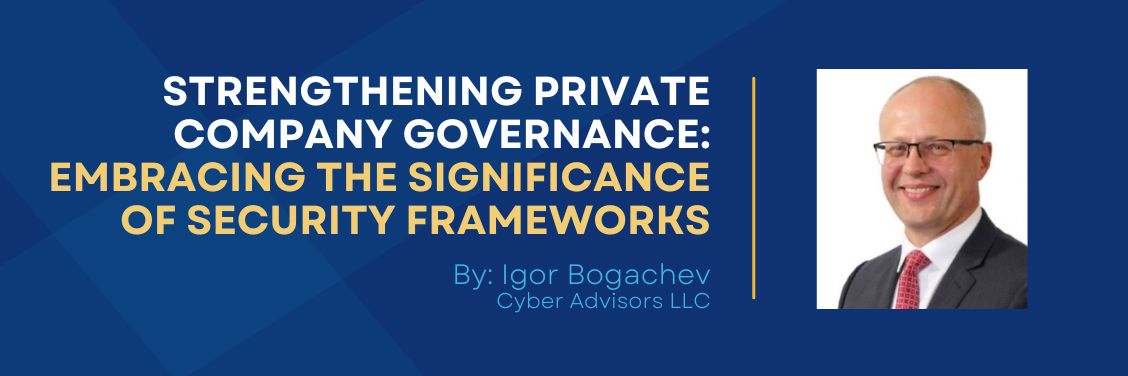Strengthening Private Company Governance: Embracing the Significance of Security Frameworks

In today's rapidly evolving digital landscape, the governance of private companies faces unprecedented challenges in safeguarding sensitive data, maintaining customer trust, and complying with an array of regulations. As technology continues to transform industries, the importance of a robust security framework cannot be overstated. This article explores the significance of adopting reputable security frameworks, such as the National Institute of Standards and Technology (NIST) framework, in the governance of private companies.
The Landscape of Private Company Governance
Private companies operate in an interconnected world where data breaches and cyber threats have become a grim reality. The financial, reputational, and legal consequences of inadequate security measures are too substantial to ignore. To navigate this landscape effectively, private companies need more than ad-hoc security measures: they require a comprehensive and structured approach to security governance.
Enter the NIST Framework, for example.
The National Institute of Standards and Technology (NIST) is a beacon of trust in the cybersecurity domain. Its Cybersecurity Framework provides private companies with a structured set of guidelines, best practices, and standards to manage and mitigate cybersecurity risks. The framework is built on five core functions: Identify, Protect, Detect, Respond, and Recover. Each function outlines specific activities that contribute to an organization's overall cybersecurity posture.
Recently, in August 2023, NIST introduced a draft of CFT 2.0 framework that includes a sixth function, that being Governance. With this change the framework’s scope has expanded — explicitly — from protecting critical infrastructure, such as hospitals and power plants, to providing cybersecurity for all organizations regardless of type or size.
1. Identify
This phase involves understanding the assets, systems, and data that need protection. By conducting risk assessments, private companies can identify vulnerabilities and prioritize their security efforts. With NIST's guidance, organizations can develop a clear picture of their risk landscape and make informed decisions about resource allocation.
2. Protect
The "Protect" function focuses on implementing safeguards to mitigate risks. This includes measures such as access controls, encryption, and secure development practices. NIST emphasizes the importance of proactive measures that ensure the confidentiality, integrity, and availability of sensitive information.
3. Detect
Detection is about recognizing and responding to security incidents promptly. NIST encourages private companies to establish continuous monitoring processes and deploy technologies that swiftly identify anomalous activities. By doing so, companies can minimize the dwell time of threats and limit potential damages.
4. Respond
In the unfortunate event of a security breach, a well-defined response strategy is paramount. NIST's framework emphasizes the importance of having an actionable incident response plan that outlines roles, responsibilities, and communication procedures. Timely and effective responses can significantly reduce the impact of a breach.
5. Recover
After a breach, recovery efforts should be focused on restoring normal operations and improving resilience. NIST underscores the significance of analyzing the incident's root causes and implementing corrective actions to prevent future occurrences. This iterative process ensures that private companies learn from their experiences and continuously enhance their security posture.
6. Governance (as it stands in the public draft)
The concept is to integrate cybersecurity risk within the spectrum of enterprise risks, akin to concerns about financial stability. Even in the absence of a dedicated governance function, businesses should have been aligning cybersecurity risks with their broader business concerns. NIST contends that there are numerous advantages to broadening the scope of governance within CSF 2.0. This novel, overarching function will underscore the vital role of cybersecurity governance in the management and mitigation of cybersecurity risks. Cybersecurity governance encompasses activities such as determining organizational priorities and risk thresholds, evaluating cybersecurity risks and their consequences, establishing cybersecurity policies and procedures, and comprehending the roles and responsibilities related to cybersecurity, not only within the organization but also in relation to customers and society at large.
Why Choose NIST?
NIST's framework stands out for its adaptability and industry relevance. It doesn't prescribe a one-size-fits-all approach; instead, it provides a flexible structure that organizations can tailor to their specific needs. Moreover, NIST collaborates with experts from various sectors, ensuring that its guidelines align with the ever-changing threat landscape.
NIST's framework also aligns with regulatory requirements and international standards. This harmony between security practices and regulations simplifies compliance efforts for private companies, helping them avoid legal pitfalls and potential financial penalties.
Certainly, besides the NIST Cybersecurity Framework that was mentioned earlier, there are several other notable security frameworks that organizations can consider implementing to enhance their security posture. Here are a few examples:
1. ISO/IEC 27001 (International Organization for Standardization/International Electrotechnical Commission)
The ISO/IEC 27001 framework is an international standard for information security management systems (ISMS). It provides a systematic approach to managing sensitive information, encompassing people, processes, and technology. ISO/IEC 27001 emphasizes risk management and focuses on maintaining the confidentiality, integrity, and availability of information assets.
2. COBIT (Control Objectives for Information and Related Technologies)
COBIT is a framework designed for the governance and management of enterprise IT systems. It provides a comprehensive framework for aligning IT with business goals, ensuring effective risk management, and maintaining regulatory compliance. COBIT emphasizes a process-based approach to IT governance and covers various domains such as planning, building, running, and monitoring.
3. CIS Critical Security Controls (previously, Center for Internet Security Controls)
The CIS Controls are a set of best practices designed to help organizations enhance their cybersecurity posture. They provide a prioritized list of actionable security measures that organizations can implement to safeguard their systems and data. The controls cover a wide range of security areas, from basic hygiene to advanced threat defense.
4. HIPAA Security Rule (Health Insurance Portability and Accountability Act)
The HIPAA Security Rule is a framework specific to the healthcare industry. It outlines security requirements for safeguarding electronic protected health information (ePHI). Covered entities and business associates must comply with HIPAA's technical, administrative, and physical safeguards to protect patient data.
5. PCI DSS (Payment Card Industry Data Security Standard)
PCI DSS is a framework designed to secure payment card data and protect cardholder information. It's particularly relevant for organizations that handle credit card transactions. The framework provides guidelines for securing payment systems, encrypting data, and maintaining a secure network infrastructure.
6. FISMA (Federal Information Security Management Act)
FISMA is a U.S. federal law that outlines information security requirements for federal agencies and their contractors. It mandates the development and implementation of security programs, risk assessments, and continuous monitoring to protect federal information and systems.
7. ITIL (Information Technology Infrastructure Library)
ITIL is a set of best practices for IT service management. While not exclusively a security framework, it includes guidelines for managing IT services in a way that aligns with business needs and enhances security. It covers aspects such as service strategy, design, transition, operation, and continual improvement.
Each of these frameworks addresses specific aspects of security and governance. Organizations often choose frameworks based on their industry, regulatory requirements, and the nature of their operations. Implementing a suitable security framework can provide a structured approach to managing risks, ensuring compliance, and enhancing overall cybersecurity readiness.
Beyond the Technical Aspects
While the technical aspects of security are critical, a comprehensive security framework like NIST goes beyond mere technology. It nurtures a security-conscious culture within private companies. Employees are educated about security risks, proper data handling, and incident reporting. This collective awareness turns every employee into a line of defense against cyber threats.
The Collaboration Advantage
Implementing a security framework involves collaboration across departments and levels. IT, legal, human resources, and management teams must unite to ensure the framework's success. This collaboration fosters a holistic understanding of security risks and solutions and promotes a culture of accountability.
Conclusion
In the contemporary business landscape, the stakes of cybersecurity have never been higher. Private companies need to safeguard their operations, protect sensitive data, and uphold customer trust. The NIST framework offers a structured approach that addresses these imperatives comprehensively. By adhering to the guidelines provided by NIST, private companies can fortify their security posture, navigate complex regulations, and foster a culture of vigilance. In an era where cyber threats are ever-present, embracing a reputable security framework is not just a good practice; it's an indispensable element of effective private company governance.

Igor Bogachev, an accomplished IT leader and strategist, brings an entrepreneurial mindset to his role as Managing Partner, CTO, Owner, and Advisory Board Member at Cyber Advisors. With a career marked by CTO roles, business ownership, and Advisory Board memberships, Igor excels in fostering enduring relationships and leveraging his business acumen for digital and business transformation. He's adept at navigating diverse ecosystems diverse ecosystems, from Eastern Europe to the USA, and specializes in aligning strategies, motivating teams, and integrating technologies for sustained growth. Igor is an active member of Entrepreneurs' Organization of Minnesota and the Private Directors Association®.
